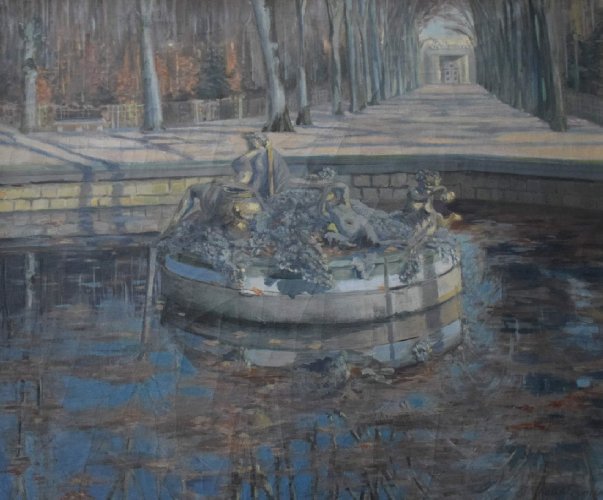Description:
Hippolyte Durand-Tahier (1863-1899) known as Paul Froment was born in 1863 in Saint-Nazaire, into a family of doctors from Nantes. He was an art critic, journalist, Parnassian poet and self-taught painter. In 1890 he became the First Secretary General of the recently reorganized Société Nationale des Beaux-Arts. He was a friend of Maxime Maufra and Paul Gauguin. He knew Pierre Puvis de Chavannes. He admired Auguste Rodin. From 1897 Hippolyte Durand-Tahier devoted himself to the passion of painting. He created under the pseudonym “Paul Froment”. From 1897 he exhibited his works at the Salons of the Société Nationale des Beaux-Arts. He died at the age of only 35. He had gathered a wonderful collection of contemporary art of the late 19th century.*
Description of the painting:
The painting located in the Rogalin gallery was created just a year before the artist’s death. It depicts one of the four pools symbolizing the seasons located in the gardens of Versailles. The titular “Pool of Bacchus” is an allegory of autumn. It presents an extremely dynamic group of sculptures of the god of wine and fertility surrounded by figures of satyrs.
The pools located in the gardens of Versailles become sculptural representations of the four seasons. One of them is adorned with a figural group with the goddess of flowers and the life-giving force – Flora, which becomes an allegory of spring. In the next one, the goddess of abundance and fertility, Ceres, lying on sheaves of wheat and field flowers, was immortalized – an allegory of summer. Then appears the symbolic representative of autumn, the god of fertility, animal nature and wine – Bacchus, shown in a lying position, surrounded by grape bunches of dark violet and golden green and the figures of small satyrs, half-humans, half-goats. In the last sculptural group, the central figure is the allegory of winter – Saturn, the god of time and sowing, shown in the company of winged hamadryads and shells **. The four Versailles pools become a symbolic representation of the uninterrupted, constantly renewing circle of life and its accompanying changes, to which the surrounding nature is subject.
The Pool of Bacchus captured by Paul Froment is located at the intersection of two avenues, the Autumn Avenue with the Avenue of Bacchus and Saturn. The road painted on canvas and adorned with bosquets leads to the palace. The artist was fascinated by the gardens of Versailles. He painted their fragments multiple times, changing the frame and the time of day. “Pool of Bacchus” being an allegory of autumn was painted by the artist precisely at this time of the year. Most of the trees are already leafless. A few of them have fallen on sculptures. In the background appear a few yellow-brown shrubs and green spruces. Like an unmovable sheet of water, like a mirror it reflects the tops of trees that did not fit in the frame of the painting. It emanates a peace of nature disproportionate to the extremely dynamic expression of the sculptural group.


